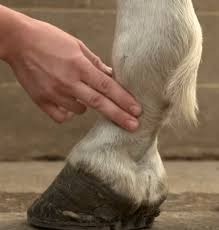First Aid for Horses: The Heart
Do you know your horses average heart rate?
I bet you don’t.
Yet it’s one of the most important baseline readings to evaluate illness, pain, stress and overexertion in your horse.
About the heart rate
Taking the pulse rate via the maxillary artery under the jaw.
A normal resting heart rate for a horse is between 28-45 beats per minute, however this is not true for every horse. Some may have a heart beat much lower, as low as 24, and some may reach as high as 50. Each 'lub-dub' counts as 1 single full heart beat.
Anxiety, pain and exercise can also increase a horse’s heart rate to as much as 200 beats per minute.
It is a good idea to have a fair understanding of what is normal for your horse, so you can identify when they are unwell. A baseline should be done over several days, during different times of the day, and after different levels of activity, to give you the best understanding of what is normal for your horse.
How to take a heart rate for a horse
To assess the heart or pulse rate, you will need a timer (watch or phone) to monitor as you count the beats. It is easiest to do the counting for 15 or 30 seconds, then times the result by 4 or 2 respectively.
There are also some great pet apps that you can download for heart or respiration rates that make the job significantly easier, and quite a few of them are free! I personally like Cardalis, which is a free app for tracking respiration rate in dogs, but works just as well for respiration and pulse rates in other animals too; but there are plenty out there, just use one that works best for you.
Locations for Taking the Heart or Pulse Rate
Taking the digital pulse rate
There are 4 ways to take the heart or pulse rate of your horse:
Use a stethoscope to listen to the heart. Place the stethoscope on the left side of the chest just under and behind the elbow.
Take the pulse rate via the Maxillary artery (under the jaw). Cup your hand on the left side of the jaw with 2 fingers under the inside of the cheek. Feel along until you left side of the jaw with 2 fingers under the inside of the cheek. Feel along until you can feel a consistent beat.
Take the pulse rate via the Digital artery (near the fetlock). The groove just above and below the outside of the fetlock is the best place to locate the digital pulse. Due to the location, it can be difficult to hold the pulse and count for the allotted time, so the digital pulse is more often used to indicate if there is a problem with the leg or foot.
Take the pulse rate via the Radial artery (inside the front knee). This is the equivalent of the wrist in people, but can be very difficult to find in some horses. Place your fingers on the inside of the knee about 3/4 of the way around to the back.
What is abnormal?
This can vary, but here are a few times I would look for further help:
The heart rate is consistently significantly higher than normal without any reason (i.e. no workout or stress factors applied). For example, if your horse’s normal heart rate is 30 beats per minute and has been sitting higher at 75 beats per minute for over half an hour, I would be suspicious.
The respiration rate is also high, or the breathing exaggerated, without exertion or stress.
There are signs of pain such as lameness, or colic symptoms.
Listening the heart through the stethoscope is muffled, or sounds a bit like a washing machine, or has a gallop rhythm (this is hard to explain without having heard one before, so if your vet ever mentions it, ask the to listen as well).
You cannot find a digital pulse and you suspect injury to the leg
You feel heat around the fetlock and the digital pulse seems to be quite ‘thumpy’
There is suspected blood loss, the pulse is weak and gums are pale.
As always, if you have concerns, seek professional assistance. But understanding what is normal and therefore abnormal for your horse may lead to faster treatment, which may save your horses life.


